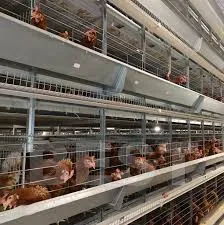Efficient Design for Broiler Chicken Transport Cages and Their Impact on Poultry Welfare
Oct . 21, 2024 12:35 Back to list
Efficient Design for Broiler Chicken Transport Cages and Their Impact on Poultry Welfare
The Importance of Broiler Transport Cages in Poultry Farming
In the poultry industry, the transportation of broilers—chickens raised specifically for meat production—is a vital process that affects not only the welfare of the birds but also the efficiency and profitability of poultry operations. One of the key components in this transportation process is the broiler transport cage. This article explores the significance of broiler transport cages, their design, and their impact on animal welfare and industry standards.
Design and Functionality
Broiler transport cages are specially designed enclosures used to transport live chickens from farms to processing plants. Their design is crucial for ensuring the safety and well-being of the birds during transport. Typically made from sturdy materials such as galvanized steel or high-density polyethylene, these cages are built to withstand the rigors of loading, unloading, and transportation over varying distances.
The size and configuration of the cages are also important factors. Cages must provide enough space for the birds to stand comfortably without overcrowding, which can lead to stress, injury, or even mortality. Moreover, features such as ventilation holes ensure adequate airflow, minimizing the risk of heat stress, especially during warmer months.
Welfare Considerations
The welfare of broilers during transportation has attracted increasing attention from animal rights advocates and regulatory bodies. Animals subjected to poor transport conditions can experience stress and trauma, negatively impacting their health and the quality of the meat produced. Therefore, the design of broiler transport cages must prioritize the birds' welfare.
Research has shown that when broilers are transported in well-designed cages, they have lower levels of stress and better survival rates. The implementation of features such as non-slip floors and individual compartments can further reduce the risk of injury. Additionally, using cages that comply with international animal welfare standards can help producers avoid potential legal repercussions and maintain a positive public image.
broiler transport cage

Industry Standards and Regulations
The poultry industry is subject to numerous regulations regarding the transport of live animals. Various organizations and government bodies, including the World Organisation for Animal Health (OIE) and local animal welfare authorities, set standards that must be adhered to. These regulations often dictate the design and maintenance of transportation cages, specifying requirements for space allocation, ventilation, and access to water.
Compliance with these standards not only protects the animals but also enhances the marketability of the poultry products. Consumers are increasingly conscientious about animal welfare, and they tend to favor products that are sourced from farms adhering to high welfare standards. As a result, investing in quality broiler transport cages can give producers a competitive edge in the market.
Economic Impact
From an economic perspective, well-designed broiler transport cages can lead to cost savings for poultry producers. Improperly managed transport can result in losses due to injuries, death, or decreased meat quality. By ensuring the safe and humane transportation of broilers, producers can reduce these risks, leading to higher yield and profit margins.
Additionally, efficient transportation can lower operational costs by optimizing routes and reducing travel times. A robust transport system that includes quality cages contributes to the overall efficiency of the supply chain.
Conclusion
In conclusion, broiler transport cages are an indispensable tool in the poultry industry. Their design and functionality play a crucial role in ensuring the welfare of the birds, complying with industry regulations, and maximizing economic efficiency. As the demand for ethically sourced poultry products continues to grow, the significance of investing in high-quality transport solutions becomes even clearer. By prioritizing animal welfare and operational efficiency, poultry producers can thrive in a competitive marketplace while promoting responsible farming practices.
-
Automatic Feeding Line System-Pan Feeder Nipple Drinker|Anping County Yize Metal Products Co., Ltd.
NewsJul.29,2025
-
Hot Sale 24 & 18 Door Rabbit Cages - Premium Breeding Solutions
NewsJul.25,2025
-
Automatic Feeding Line System Pan Feeder Nipple Drinker - Anping County Yize Metal Products Co., Ltd.
NewsJul.21,2025
-
Automatic Feeding Line System Pan Feeder Nipple Drinker - Anping County Yize Metal Products Co., Ltd.
NewsJul.21,2025
-
Automatic Feeding Line System - Anping Yize | Precision & Nipple
NewsJul.21,2025
-
Automatic Feeding Line System - Anping Yize | Precision & Nipple
NewsJul.21,2025






